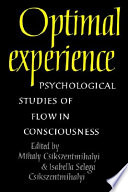

The book introduces the concept of 'flow,' a mental state where individuals become fully immersed in an activity, leading to enhanced performance and satisfaction. This state is characterized by a balance between challenge and skill, where individuals feel a sense of control and intrinsic motivation. Flow is essential for achieving optimal experiences in various activities, whether in work, sports, or creative pursuits. The authors emphasize that understanding how to induce flow can lead to greater happiness and fulfillment in life.
Continue readingTo achieve flow, certain conditions must be met, including having clear goals, receiving immediate feedback, and maintaining a balance between skill level and challenge. The book discusses how these elements create an environment conducive to flow, allowing individuals to engage deeply in their tasks. By recognizing and structuring activities that meet these criteria, people can enhance their likelihood of experiencing flow, leading to improved performance and satisfaction.
Continue readingIntrinsic motivation plays a crucial role in achieving optimal experiences. The authors argue that activities pursued for their own sake, rather than for external rewards, are more likely to lead to flow. This intrinsic drive fosters creativity, persistence, and resilience, enabling individuals to push through challenges and achieve higher levels of performance. The book encourages readers to identify and cultivate their intrinsic motivations to enhance their overall quality of life.
Continue readingThe book explores how flow experiences can significantly impact learning and personal development. When individuals engage in activities that induce flow, they are more likely to absorb information, develop new skills, and enhance their overall competence. The authors suggest that educators and leaders should create environments that promote flow to facilitate better learning outcomes and personal growth, highlighting the importance of fostering optimal experiences in educational settings.
Continue readingFlow is not limited to leisure activities; it can also be applied to work and productivity. The authors discuss how organizations can create conditions that foster flow among employees, leading to increased engagement, creativity, and productivity. By aligning tasks with employees' skills and providing autonomy, feedback, and clear goals, businesses can cultivate a culture that promotes optimal experiences, resulting in better performance and employee satisfaction.
Continue readingThe relationship between flow and well-being is a central theme in the book. The authors argue that experiencing flow contributes to overall happiness and life satisfaction. By engaging in activities that induce flow, individuals can enhance their mental health, reduce stress, and improve their quality of life. The book encourages readers to seek out and prioritize activities that lead to flow to cultivate a more fulfilling and meaningful existence.
Continue readingFinally, the book provides practical strategies for individuals and organizations to cultivate flow experiences. This includes setting clear goals, seeking feedback, and balancing challenge and skill. The authors also emphasize the importance of mindfulness and being present in the moment to enhance the likelihood of experiencing flow. By applying these strategies, readers can create optimal experiences in various aspects of their lives, from personal pursuits to professional endeavors.
Continue reading